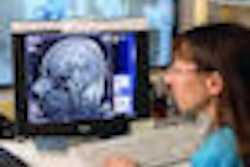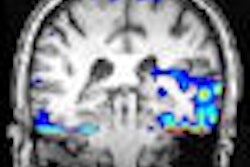Two U.S. universities were able to eliminate cases of nephrogenic systemic fibrosis (NSF) among their patients receiving MRI scans by switching to a different gadolinium-based contrast agent and by adopting stricter guidelines for contrast use, according to a study published online this month in Radiology.
NSF is a debilitating and sometimes fatal condition that can cause fibrosis of the bone, kidneys, lungs, muscle, and other structures. Although its etiology is not fully understood, it has been most closely connected to patients with kidney problems who receive large doses of gadolinium-based contrast agents (GBCA).
Much of the research into the relationship between gadolinium contrast and NSF has focused on whether the disease is caused by a specific formulation of gadolinium, or whether NSF is caused by the entire class of agents. Researchers at Emory University Hospital in Atlanta and the University of North Carolina (UNC) at Chapel Hill sought to answer this question by tracking their experience in switching to a new gadolinium formulation and also adopting stricter guidelines for gadolinium contrast use.
Study results were published online in Radiology on October 7, with Dr. Ersan Altun from the department of radiology in the School of Medicine at UNC as the lead author.
Transition period
Researchers at UNC collected data on NSF patients over three periods: January 2000 to December 2006, before the changes in contrast product and administration policies; a transitional period from January 2007 to May 2007; and from June 2007 to June 2008, which followed adoption of the changes.
At Emory, NSF patient data were collected prior to the changes from October 2003 to February 2007, during the transition period of March 2007 to May 2007, and during the postadoption period of June 2007 to June 2008.
Both centers used gadodiamide (Omniscan, GE Healthcare, Chalfont St. Giles, U.K.) as their only GBCA for all gadolinium-enhanced MR imaging in all patients prior to the changes. Beginning in June 2007, the facilities switched to gadobenate dimeglumine (MultiHance, Bracco Diagnostics, Princeton, NJ) and gadopentetate dimeglumine (Magnevist, Bayer HealthCare Pharmaceuticals, Wayne, NJ) for all gadolinium-enhanced MRI studies.
The facilities replaced gadiodiamide with gadobenate dimeglumine in all gadolinium-enhanced MRI studies of adult patients, patients less than one year of age, and pediatric patients at risk for the development of NSF. Gadopentetate dimeglumine also replaced gadodiamide in all gadolinium-enhanced MRI exams for pediatric patients older than one year and those considered not at risk for the development of NSF.
Contrast decisions
The authors wrote that they chose gadobenate dimeglumine because it had "the highest T1 relaxivity among all GBCA agents, the highest thermodynamic stability among all linear chelates that were approved by the U.S. Food and Drug Administration (FDA) during the study period, and because it was the only GBCA with dual (hepatorenal) elimination available in the United States at the time of the study."
Gadopentetate dimeglumine was used because of its FDA approval for pediatric applications and its higher thermodynamic stability and lower dissociation rate compared to gadodiamide.
Patients at risk for NSF were defined having stage 4 or 5 chronic renal disease, undergoing dialysis, having acute renal insufficiency of any severity, and having received a liver transplant. Low-risk patients for NSF were defined as patients with stage 3 chronic renal disease, children less than one year of age, and patients who were pregnant.
Restrictive policies regarding the use of gadolinium-based agents were adopted at both institutions in June 2007 following transition periods to reduce the risk of NSF. The guidelines include using half doses on gadobenate dimeglumine for patients with stage 1 or stage 2 kidney disease and renal transplants.
GBCA policies at Emory and University of North Carolina
|
||||||||||||||||||||
| Source: Radiology, Emory University, and University of North Carolina. |
Prior to the changes, 49,010 patients underwent gadolinium-enhanced MR imaging at UNC, with 925 of those patients considered at risk for NSF. Thirty-five patients were found to have NSF.
While 28 of those 35 patients were studied previously, seven patients with NSF were identified for the first time. All seven of these patients underwent gadolinium-enhanced MRI before January 2007. Five of the seven patients received gadolinium-enhanced MR at this facility only.
Following the changes, 10,477 patients received gadolinium-enhanced MR imaging at the center, with 147 of those patients at risk for NSF and 1,241 (12%) pediatric patients. The study found no cases of NSF among the patient population.
At Emory, there were 16,230 patients who underwent gadolinium-enhanced MR imaging, with 312 of them deemed at risk before the contrast substitutions and policy changes. The study found 14 patients with NSF during that time. Nine of the 14 patients underwent gadolinium-enhanced MR scans exclusively at this facility, with those patients only receiving gadodiamide. Researchers could not determine a relationship between gadolinium administration and NSF in five patients.
Following the changes, 14,690 patients underwent gadolinium-enhanced MRI scans, with 402 of those patents on dialysis. In the follow-up period between July 2008 and March 2009, no patients with NSF were detected at either facility.
Based on the results, the authors noted "particular GBCAs may have different frequencies of association with NSF and that stable GBCAs may have a low or nearly nonexistent frequency of association with NSF, depending on the type of GBCA."
Guideline effectsThe authors concluded that their new gadolinium utilization policies "contributed substantially to the decrease in the incidence of NSF," and the findings supported their hypothesis that particular gadolinium agents "may have different frequencies of association with NSF and that stable GBCAs may have a low or nearly nonexistent frequency of association with NSF, depending on the type of GBCA."
They emphasized that their results "should not be interpreted as an end point in safety, but rather a positive sampling point that the current strategy appears to be a safe one. We intend to constantly monitor the results of our findings."
The study also cited several limitations, including its retrospective review and follow-up technique "in which the use of ICD codes and administrative data might overlook some patients with NSF at both centers." To counter that limitation, the researchers cross-referenced various databases, including those of the pathology and dermatology departments involved in the diagnosis of NSF.
The use of a relatively short follow-up period also was cited as a possible limitation. Because NSF generally develops in two to three months following gadolinium exposure in the majority of patients, the follow-up of patients who may have developed NSF after nine months was limited.
By Wayne Forrest
AuntMinnie.com staff writer
October 15, 2009
Related Reading
Mayo study finds few serious reactions to CT and MRI contrast, September 21, 2009
Gadolinium-based contrast agents alone don't cause NSF, study finds, July 8, 2009
JHU study: Screening patients prior to MRI lowers NSF risk, February 4, 2009
ACR committee works toward gadolinium-based contrast policy, October 24, 2008
Hemodialysis helps prevent NSF in some patients, study finds, August 19, 2008
Copyright © 2009 AuntMinnie.com



















